Cycling Knee Injury
Despite the fact that the knee joint moves the most during cycling vs other sports, and the most force is created through the knee via the quadriceps muscle, a cycling knee injury is a relatively rare phenomenon. In fact, many athletes in other sports such as football, basketball, soccer, etc. that put a pounding on the knee joint and whose athletes suffer such injuries as torn meniscus (cartilage) and torn anterior cruciate ligaments ( ACL) or medial collateral ligaments ( MCL) are usually rehabed back to health with the use of a cycle ergometer combined with strength training.
The more common cycling knee injury will be repetitive motion problems due to faulty underlying biomechanics that cause an overuse syndrome. These include quadriceps or patellar tendonitis, ilial-tibial band syndrome and rarely hamstring tendonitis. Rarely will there be an injury from cycling be an actual knee joint issue. Even those people with severe degenerative joint disease of the knee joint are usually able to cycle on a bike and benefit from it. There is not the trauma to the joint that there is with weight bearing exercise. The perfect bike fit for an individual and his/her bike means the marriage of the two is also perfect. This means the various settings of seat height, saddle position, foot/cleat position, toe-in vs toe-out, stem height and/or stem length and Q factor distance must be optimized to the specific individual's unique biomechanics, geometry, flexibility and goals. Foot pronation and/or supination is another often critical fitting factor that is often missed and best fixed by custom made cycling orthotics that are worn in one's everyday shoes as well as in their cycling shoes. Keeping the foot in a neutral position has tremendous benefits for knee function when riding.
The Q factor is an often overlooked factor in bike fitting that when ignored, is a major contributing factor to cycling knee injury. Lateral knee pain is very commonly related to a Q factor that is too narrow as is pain from the foot all the way up to the hip while riding in many cyclists. The Q factor specifically is the distance between the feet when placed on the pedals. Road bikes tend to have a narrower Q factor than mountain bikes due to a narrower bottom bracket. Recumbent cyclists often benefit from a wider Q factor due to the natural "knees out" position one's knees assume when in the sitting position.
When I began bike fitting in the mid-1980's it became apparent to me that there was need to move people's feet apart to a wider position on the pedals for all sorts of reasons including larger body size, larger feet, a toe out gait pattern, bow legged structure and various other biomechanical issues. Often times the problem is on one side only often due to an old fracture with healing of the foot in an outward bound position that the bike must be fixed to accommodate.
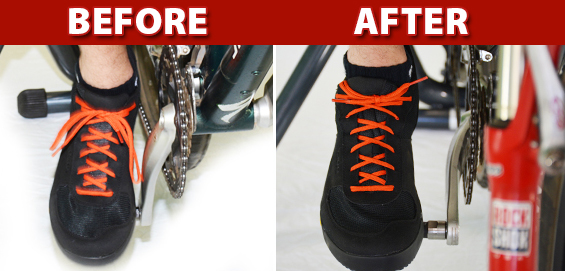
Mobile Bike Fitting Services Available
Randy Ice PT, CCS offers a mobile bike fitting program that can resolve your pain syndrome and/or optimize your power output where others have failed. He travels all over Southern California to make the process easy for you.
Call (760) 468-4718 for more information or an appointment. The following "Principles of Bike Fitting: What Factors Make For An Optimal Fit" PowerPoint Presentation will take you through the process of achieving an optimal bike fit and the how to's of relieving/preventing cycling biomechanical pain syndromes. The little understood and discussed "Q Factor" as well as the development of Kneesavers™ is also presented.
Optimal Bicycle Fitting:
What Factors Make For An Optimal Fit
About Us
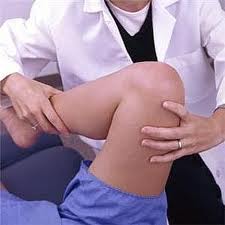
Our Vision
Randy Ice PT, CCS is a cardiopulmonary physical therapist who began bike fitting services in 1987. He has over 30 years of experience and has fitted hundreds of men and women cyclists to make their cycling experience more comfortable.
Early on, he recognized the limitations of fixed Q factor spacing on bicycles, especially road and recumbent bikes, and invented Kneesavers™ pedal extenders. This allowed for the fact that different sized cyclists with differing biomechanical needs needed differing distances between the pedals while riding.
His vision lead to (3) different Kneesavers™ widths, Kneesavers™ that fit both road and stationary bikes, Pedal Adapters that allow one to use their cycling pedals and shoes on spin trainers or stationary bikes, Titanium Kneesavers™ and custom made Kneesavers™ of any length and thread size as needed. He continues to develop ways of improving cycling mechanics for both recreational and competitive cyclists to improve speed and/or comfort.
His expertise in this area has also lead him into creating the world's most nutritionally complete energy drink/meal replacement (www.SPIZ.net) and the establishment of a bio-identical hormone replacement program in Temecula, California (www.VintageMedicalGroup.com).
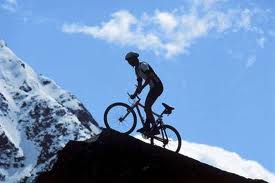
Our Business
All Kneesavers™ products are manufactured in the United States under strict machining controls and standards.....no "made in China" of ? quality here. Our business depends on complete customer satisfaction as we ship within 24 hours of receipt of your order. We also offer a full 100% money back guarantee that Kneesavers™ will solve your problem or we will refund your money.
Also, if for some reason you find you have selected the wrong size and need a longer or shorter pair of Kneesavers™, we will gladly exchange them at anytime for a $5 restocking fee only.
We offer telephone consultations at no cost to advise you of which size and thread type you need should you be unsure what it is you need. We are also the only pedal extender company that offers custom made Kneesavers™ should you need a long pair than our stock offerings.
For an in-depth Power Point presentation of all aspects of bike fitting including the Q factor that illustrates all the different cycling pain syndromes and how they are best relieved, see my presentation "The Importance of Proper Q Factor Alignment in Cycling" elsewhere on this website.
Benefits

- Moves your pedals further apart, widing the Q Factor
- Allows more toe out and puts the foot/tibia/femur into straight alignment
- Precision made of stainless steel
- Available in 3 different widths for road, mountain or recumbent bikes
- Available in 2 widths for stationary bikes or trainers
- Titanium Kneesavers™ available
- Pedal Adapters that allow 9/16" threaded pedals to be used on 1/2" threaded stationary bike crank arms
- Easy to install
- Made in America by an American!
His vision lead to (3) different Kneesavers™ widths, Kneesavers™ that fit both road and stationary bikes, Pedal Adapters that allow one to use their cycling pedals and shoes on spin trainers or stationary bikes, Titanium Kneesavers™ and custom made Kneesavers™ of any length and thread size as needed. He continues to develop ways of improving cycling mechanics for both recreational and competitive cyclists to improve speed and/or comfort.
His expertise in this area has also lead him into creating the world's most nutritionally complete energy drink/meal replacement (www.SPIZ.net) and the establishment of a bio-identical hormone replacement program in Temecula, California (www.VintageMedicalGroup.com).

Our Business
All Kneesavers™ products are manufactured in the United States under strict machining controls and standards.....no "made in China" of ? quality here. Our business depends on complete customer satisfaction as we ship within 24 hours of receipt of your order. We also offer a full 100% money back guarantee that Kneesavers™ will solve your problem or we will refund your money.
Also, if for some reason you find you have selected the wrong size and need a longer or shorter pair of Kneesavers™, we will gladly exchange them at anytime for a $5 restocking fee only.
We offer telephone consultations at no cost to advise you of which size and thread type you need should you be unsure what it is you need. We are also the only pedal extender company that offers custom made Kneesavers™ should you need a long pair than our stock offerings.
For an in-depth Power Point presentation of all aspects of bike fitting including the Q factor that illustrates all the different cycling pain syndromes and how they are best relieved, see my presentation "The Importance of Proper Q Factor Alignment in Cycling" elsewhere on this website.

SCOR PRODUCTIONS KNEESAVERS PEDAL ADAPTERS
By Charlie Coyne
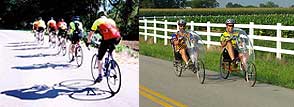
While it is true that I have two of the most studly knees around, their beauty had sadly only been skin deep earlier this year.
On longer rides, especially on some recumbents, unfair pain had been limiting my speed, distance and endurance.
The problem was especially bad when putting miles on the Longbike's Slipstream, reviewed recently in RTR issue #13. I had really began to wonder whether I would be able to complete the century that were in the plans for this season. As wonderfully comfortable as the Slipstream rides, my knees were just about shot after the first 15-20 miles.
Then the pain around the outboard diameter of my kneecaps would become to sharp to allow enjoyable riding. I have always adjusted my clip-less pedals to allow the maximum amount of toe-out, but the limiting factor was always the interference between the crank arm and my heels.
Perhaps it's was the unique geometry form the Longbike's crankarm height, crankarm length, seat height/angle and seatback angle, combined with my own hip/leg geometry that really aggravated the apparent misalignment of my knees, but the problem had escalated to the point that I was whining about it to my riding buddies, so you know how serious it really was.
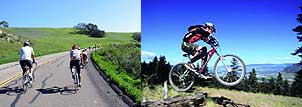
It's funny how you can look at the solution to a problem for a long time without actually seeing it. In my case, I had seen the Kneesavers ads in RTR many, many times in past issues. One day, while reading the ad again it finally dawned on me that they might help me with my knee pain plight.
A quick look at the website revealed much (www.bikescor.com).
Kneesavers are simple. Machined and case-hardened from billets of stainless steel, they fit between the crank arms and the pedals. Sold in pairs or individually, Kneesavers Pedal Adapters come in 20mm, 25mm and 30mm widths. The standard width is 20mm, which weights 6.1 ounces per pair. For all of you weight warriors, titanium Kneesavers are also available, in 20mm length only, and they are more costly.

The standard Kneesaver adapter 's additional 20mm. spacing moves the pedals away from the crank arms up to 25 degrees of toe-out before the riders heels hit the crank arms. Most fixed and floating-pedal systems allow a maximum of 4-5 degrees of toe out before heel/ crankarm interference occurs. Up to 45 degrees of toe-out is possible with the longer 30mm. Kneesavers.
A phone call to the company's toll free number- 1-800-548-4447- had a pair of 20mm.
stainless Kneesavers on the way to me after a charge of $45.00 plus $3.00 for shipping. Within a few days the package arrived via US mail. As is evident in the photo, Kneesavers are really quite simple. What isn't evident is how finely they are precision-machined, likely to closer tolerances than many pedals on the market. At first blush, it seemed that $45.00 was a lot for some simple pedal spacers, but hey, the money was already spent so onto the bike they went. Besides, after enduring such a lengthy period of riding pain, I was just about the point where money was no object. It's hard to know what to say about Kneesavers without sounding like over the top hype. One of life's never-failing truisms is that if something sounds too good to be true, it is. I am particularly skeptical when it comes to health claims. Magic mumbo-jumbo that help you melt off fat, gain weight, improve your memory, increase size and stamina, the world is full of them and the people that buy them. My wife insists that I take my vitamins each day, so I do, but I avoid so much as an aspirin and the like unless I am really suffering. I've been blessed with pretty good health so far, without using a lot of additives.
So when I first clipped into the SPD pedals after the installation I was amazed. Without even so much as turning a pedal, I could feel a profound difference while I braced the bike against the workbench. My hips, knees and feet felt perfectly "lined-up" and centered the instant the pedals clicked in. A quick trip down the street on the Slipstream had me thinking that we might be on to something here. Even without adapters, a quick spin would not have incited the knee pain, so it wasn't the absence of pain that had me excited. I guess it was the feel that everything was finally aligned correctly, and the prospect of long rides was alive once again. I put several hundred miles on the slipstream after equipping it with the Kneesavers. I wanted to make sure that they were the "real deal" before writing an evaluation. To be honest, the pain did return in the first few long rides, but it took longer and longer for it to occur, and it was certainly less severe. I believe that a good part on the continued pain was from the inflammation that just took some time to heal. I also adjusted the cleats on my shoes to the position closest to the heal which also seemed to help.
Over time, my legs have actually become stronger from being able to pedal without the pain. I think that I had been unconsciously contorting my knees, ankles and feet to avoid and alleviate the pain. With the kneesavers, I could now apply full pressure throughout the powerstroke without fear, and I could feel muscles in my legs firing that I hadn't felt before. Longer and longer rides became possible, climbing hills was easier and my overall speeds picked up. I was fully confident and ready for the first century of the season, the Solvang Century in Solvang, California. My knee problems were most pronounced on recumbents. On upright bike, it would take the better part of a century about the 60-70 mile mark before I would have any trouble with my knees. So far, I have not ridden an upright with the Kneesavers, so I can't report about their effectiveness in such an installation. But that's OK with me. The Kneesavers have been the best $48.00 riding accessory I have bought in many years. I may give some thought to a pair of $100.00 titanium units.
Contact: SCOR Productions at:
P.O. Box 2466
Fallbrook, CA 92028
Tel: 800.548.4447
Fax: 760.728.0571
